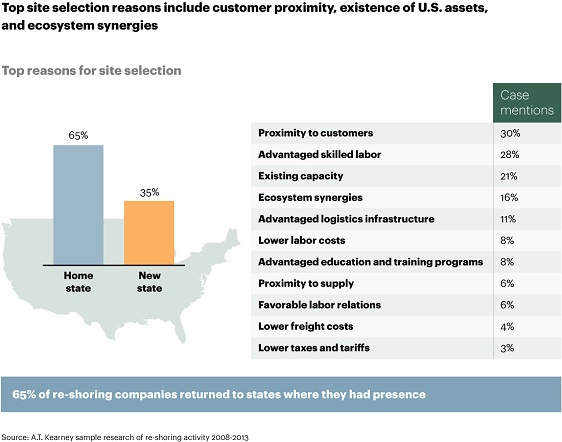A.T. Kearney: Reshoring efforts are slowing down
Global strategy and management consulting firm releases its first study on the pace of the return of manufacturing operations to the U.S.
Latest Material Handling News
Registration open for Pack Expo International 2024 Walmart chooses Swisslog AS/RS and software for third milk processing facility NetLogistik partners with Vuzix subsidiary Moviynt to offer mobility solutions for warehouses Lucas Watson appointed CSO for Körber’s Parcel Logistics business in North America Hyster recognizes Dealers of Distinction for 2023 More NewsGlobal strategy and management consulting firm A.T. Kearney has released its 2014 Reshoring Index, the first in a series of studies looking objectively at the rate and pace of the return of manufacturing operations to the U.S.
In this inaugural Index, manufactured goods flows are tracked over a 10-year period to show the change in ratio between U.S. manufacturing imports and gross output during that time period. The index is actually expected to show a year-over-year decline, lower by 20 basis points from 2013, as offshoring to foreign manufacturing markets outpaces reshoring.
Patrick Van den Bossche, A.T. Kearney partner and leader of the firm’s Americas Strategic Operations Practice and co-author of the Index, notes, “Our goal was to find out for ourselves whether companies are indeed leaning toward reshoring operations, and if so, what are the motivators driving them. We’ve been following these questions with interest since 2010, and have a growing database of 700+ reshoring cases across all industries.”
“While the so-called reshoring trend has helped improve the mood of U.S. manufacturing since the Recession, the reality is that the import value of manufactured goods into the U.S. from 14 low-cost Asian countries has grown at an average of 8% per year in the last five years,” added Pramod Gupta, A.T. Kearney principal and study co-author. “The 2014 Reshoring Index is not only an indicator of U.S. manufacturing capital flows, but also how the U.S. stacks up in terms of attractiveness as a source of manufactured products versus countries like China, Bangladesh, and Cambodia.”

Key highlights include:
● The top three reshoring industries, as measured by the number of cases in A.T. Kearney’s database, are electrical equipment, appliance and component manufacturing, with 15% of the cases; transportation equipment manufacturing, with 15%; and apparel manufacturing, which previously had not been expected ever to come back, with 12%.
Improvement in delivery time led the reasons executives gave in favor of reshoring, with quality improvement a close second and followed by brand/image. While there has been an overall lift in U.S. manufacturing for five straight years since 2009, imports of offshored manufactured goods into the U.S. have increased at a faster rate than any return of manufacturing operations to our soil and, for the 14 top offshoring locations combined, amounted to $630 billion in 2013.
Those 14 top offshoring locations (China, Taiwan, Malaysia, India, Vietnam, Thailand, Indonesia, Singapore, Philippines, Bangladesh, Pakistan, Hong Kong, Sri Lanka, and Cambodia) are also included in the study, along with a tracking of the year-over-year change in Manufacturing Import Ratio (see below) from 2004 through 2014.


Article Topics
Latest in Materials Handling
Registration open for Pack Expo International 2024 Walmart chooses Swisslog AS/RS and software for third milk processing facility NetLogistik partners with Vuzix subsidiary Moviynt to offer mobility solutions for warehouses Materials Handling Robotics: The new world of heterogeneous robotic integration BSLBATT is looking for new distributors and resellers worldwide Lucas Watson appointed CSO for Körber’s Parcel Logistics business in North America Hyster recognizes Dealers of Distinction for 2023 More Materials HandlingSubscribe to Materials Handling Magazine

Find out what the world's most innovative companies are doing to improve productivity in their plants and distribution centers.
Start your FREE subscription today.
April 2024 Modern Materials Handling

Latest Resources










